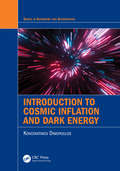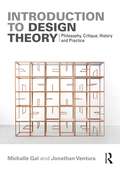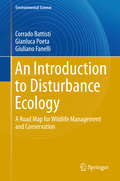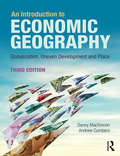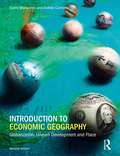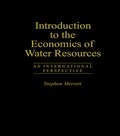- Table View
- List View
Introduction to Cosmic Inflation and Dark Energy (ISSN)
by Konstantinos DimopoulosCosmic inflation and dark energy hold the key to the origin and the eventual fate of the Universe. Despite the increasing prominence of these subjects in research and teaching over the past decade or more, no introductory textbook dedicated to these topics has been previously published. Dr. Konstantinos Dimopoulos is a highly regarded expert in the field, and an experienced communicator of the subject to students. In this book, he provides advanced undergraduate and early graduate students with an accessible introduction and equips them with the tools they need to understand the cosmology of cosmic inflation and dark energy.Features: Provides a concise, pedagogical "crash course" in big bang cosmology, focusing on the dynamics and the history of the Universe, with an emphasis on the role of dark energy Chapters contain questions and problems for readers to test their understanding The first book to make cosmic inflation and dark energy accessible to students
Introduction to Cosmic Inflation and Dark Energy (ISSN)
by Konstantinos DimopoulosCosmic inflation and dark energy hold the key to the origin and the eventual fate of the Universe. Despite the increasing prominence of these subjects in research and teaching over the past decade or more, no introductory textbook dedicated to these topics has been previously published. Dr. Konstantinos Dimopoulos is a highly regarded expert in the field, and an experienced communicator of the subject to students. In this book, he provides advanced undergraduate and early graduate students with an accessible introduction and equips them with the tools they need to understand the cosmology of cosmic inflation and dark energy.Features: Provides a concise, pedagogical "crash course" in big bang cosmology, focusing on the dynamics and the history of the Universe, with an emphasis on the role of dark energy Chapters contain questions and problems for readers to test their understanding The first book to make cosmic inflation and dark energy accessible to students
Introduction to Cryospheric Science (Springer Geography)
by Dahe Qin Tandong Yao Yongjian Ding Jiawen RenThis book introduces systematically the cryospheric science, covering the formation, development, evolution, and research methods of each component of the cryosphere, the interaction between the cryosphere and the other spheres of the climate system and the anthroposphere, and the hot topics of social and economic sustainable development and geopolitics. The authors are world-renowned experts and scientists working in the related fields. They have a deep understanding and accurate grasp of the basic theory, evolution mechanism, and international frontiers of the cryosphere, as well as rich teaching experience, which makes this book suitable also as textbook for graduate students. It is also the first book that introduces the knowledge of cryospheric science systematically. In addition to theoretical knowledge, the book also introduces field work and experimental analysis. It should be of interests for the scholars and graduate student working in the fields of geography, hydrology, geology, geomorphology, atmosphere, ecology, environment, oceanography, and regional economic and social sustainable development.
Introduction to Crystallography
by Frank HoffmannThis book invites you on a systematic tour through the fascinating world of crystals and their symmetries. The reader will gain an understanding of the symmetry of external crystal forms (morphology) and become acquainted with all the symmetry elements needed to classify and describe crystal structures. The book explains the context in a very vivid, non-mathematical way and captivates with clear, high-quality illustrations. Online materials accompany the book; including 3D models the reader can explore on screen to aid in the spatial understanding of the structure of crystals. After reading the book, you will not only know what a space group is and how to read the International Tables for Crystallography, but will also be able to interpret crystallographic specifications in specialist publications. If questions remain, you also have the opportunity to ask the author on the book's website.
Introduction to Design Theory: Philosophy, Critique, History and Practice
by Michalle Gal Jonathan VenturaIntroduction to Design Theory introduces a comprehensive, systematic, and didactic outline of the discourse of design. Designed both as a course book and a source for research, this textbook methodically covers the central concepts of design theory, definitions of design, its historical milestones, and its relations to culture, industry, body, ecology, language, society, gender and ideology. Demonstrated by a shift towards the importance of the sociocultural context in which products are manufactured and embedded, this book showcases design theory as an emerging sub-discipline of design, unique in its practice-based approach and its broad perception of design. It offers an in-depth understanding of the central concepts, such as "form" and "function", "theory" and "practice", through a discussion of key case studies and historical examples, such as the advent of the view of design in antiquity, the introduction of mass production to modernist design or the ideological shifts in design in the mid-twentieth century, as well as analytical tools for further dissection and learning in practice. With a focus on a combination of several theoretical knowledge foundations — aesthetics and philosophy, critical theories, cultural studies, design history and design anthropology — the reader is enabled to approach design as a central pivot around which contemporary culture revolves, reflecting, reaffirming or challenging social and cultural structures. Aimed towards undergraduate and postgraduate students, as well as teachers and scholars, from across the design disciplines, Introduction to Design Theory invites readers to engage with design from an interdisciplinary perspective, departing from the traditional academic compartmentalisation of practice, history and philosophy.
Introduction to Design Theory: Philosophy, Critique, History and Practice
by Michalle Gal Jonathan VenturaIntroduction to Design Theory introduces a comprehensive, systematic, and didactic outline of the discourse of design. Designed both as a course book and a source for research, this textbook methodically covers the central concepts of design theory, definitions of design, its historical milestones, and its relations to culture, industry, body, ecology, language, society, gender and ideology. Demonstrated by a shift towards the importance of the sociocultural context in which products are manufactured and embedded, this book showcases design theory as an emerging sub-discipline of design, unique in its practice-based approach and its broad perception of design. It offers an in-depth understanding of the central concepts, such as "form" and "function", "theory" and "practice", through a discussion of key case studies and historical examples, such as the advent of the view of design in antiquity, the introduction of mass production to modernist design or the ideological shifts in design in the mid-twentieth century, as well as analytical tools for further dissection and learning in practice. With a focus on a combination of several theoretical knowledge foundations — aesthetics and philosophy, critical theories, cultural studies, design history and design anthropology — the reader is enabled to approach design as a central pivot around which contemporary culture revolves, reflecting, reaffirming or challenging social and cultural structures. Aimed towards undergraduate and postgraduate students, as well as teachers and scholars, from across the design disciplines, Introduction to Design Theory invites readers to engage with design from an interdisciplinary perspective, departing from the traditional academic compartmentalisation of practice, history and philosophy.
Introduction to Designing Environments: Paradigms & Approaches (Designing Environments)
by Michael U. Hensel Defne Sunguroğlu Hensel Claudia R. Binder Ferdinand LudwigThe Designing Environments book series addresses questions regarding necessary environmental transformation in the context of the fast-unfolding environmental crisis. This is done from a broad interdisciplinary perspective, examining the negative impact of human transformations of the environment and providing different inroads towards sustainable environmental transformation with net positive impact.Volume one of the Designing Environments book series brings together experts from different disciplines and often inter- and transdisciplinary contexts, who discuss specific approaches to overcoming the negative impact of the transformation of environments by humans. Across the 12 chapters of volume one, specific keywords recur that are indicative of shared insights and concerns. These include Anthropocene, climate change, complexity, critical zone, ecosystem services, and sustainability. Furthermore, interdisciplinary approaches to human–environment interactions, sustainability transitions, and socio-ecological systems take center stage and are discussed in relation to conceptual and methodological as well as societal and technological challenges and opportunities.
Introduction to Development Engineering: A Framework with Applications from the Field
by Richard Anderson Kenneth Lee Temina Madon Ashok J. Gadgil Lorenzo Casaburi Arman RezaeeThis open access textbook introduces the emerging field of Development Engineering and its constituent theories, methods, and applications. It is both a teaching text for students and a resource for researchers and practitioners engaged in the design and scaling of technologies for low-resource communities. The scope is broad, ranging from the development of mobile applications for low-literacy users to hardware and software solutions for providing electricity and water in remote settings. It is also highly interdisciplinary, drawing on methods and theory from the social sciences as well as engineering and the natural sciences.The opening section reviews the history of “technology-for-development” research, and presents a framework that formalizes this body of work and begins its transformation into an academic discipline. It identifies common challenges in development and explains the book’s iterative approach of “innovation, implementation, evaluation, adaptation.” Each of the next six thematic sections focuses on a different sector: energy and environment; market performance; education and labor; water, sanitation and health; digital governance; and connectivity. These thematic sections contain case studies from landmark research that directly integrates engineering innovation with technically rigorous methods from the social sciences. Each case study describes the design, evaluation, and/or scaling of a technology in the field and follows a single form, with common elements and discussion questions, to create continuity and pedagogical consistency. Together, they highlight successful solutions to development challenges, while also analyzing the rarely discussed failures. The book concludes by reiterating the core principles of development engineering illustrated in the case studies, highlighting common challenges that engineers and scientists will face in designing technology interventions that sustainably accelerate economic development.Development Engineering provides, for the first time, a coherent intellectual framework for attacking the challenges of poverty and global climate change through the design of better technologies. It offers the rigorous discipline needed to channel the energy of a new generation of scientists and engineers toward advancing social justice and improved living conditions in low-resource communities around the world.
An Introduction to Dirac Operators on Manifolds (Progress in Mathematical Physics #24)
by Jan CnopsThe chapters on Clifford algebra and differential geometry can be used as an introduction to the topics, and are suitable for senior undergraduates and graduates. The other chapters are also accessible at this level.; This self-contained book requires very little previous knowledge of the domains covered, although the reader will benefit from knowledge of complex analysis, which gives the basic example of a Dirac operator.; The more advanced reader will appreciate the fresh approach to the theory, as well as the new results on boundary value theory.; Concise, but self-contained text at the introductory grad level. Systematic exposition.; Clusters well with other Birkhäuser titles in mathematical physics.; Appendix. General Manifolds * List of Symbols * Bibliography * Index
An Introduction to Disturbance Ecology: A Road Map for Wildlife Management and Conservation (Environmental Science and Engineering)
by Corrado Battisti Gianluca Poeta Giuliano FanelliThis book represents an introductory review of disturbance ecology and threat analysis, providing schematic concepts and approaches useful for work on sites that are affected by the impact of human actions. It is aimed at conservation and environmental practitioners, who will find tips for choosing methods and approaches when there are conflicts between the natural components and human activity. It is also addressed to students of applied ecology, ecosystem management, land-use planning and environmental impact assessment. It discusses a number of topics covered in the programs of many university courses related to basic ecology and ecology of disturbance, the latter constituting a field of great interest because of its implications and repercussions in applied territorial science. The book is divided into two parts: the first focuses on the theoretical and disciplinary framework of the ecology of disturbance, while the second is devoted to the analysis of anthropogenic threats. This, in particular, discusses the most recent approach, which uses a conventional nomenclature to allow a coarse-grained quantification and objective assessment of threat impact on different environmental components. Such an approach facilitates the comparison of hierarchically different events and, therefore, helps define the priorities for management and conservation strategies.
An Introduction To Dynamic Meteorology (PDF)
by James R. Holton Gregory J. HakimDuring the past decade, the science of dynamic meteorology has continued its rapid advance. The scope of dynamic meteorology has broadened considerably. Much of the material is based on a two-term course for seniors majoring in atmospheric sciences. This book presents a cogent explanation of the fundamentals of meteorology and explains storm dynamics for weather-oriented meteorologists. It discusses climate dynamics and the implications posed for global change. The new edition has added a companion website with MATLAB exercises and updated treatments of several key topics. Provides clear physical explanations of key dynamical principles Contains a wealth of illustrations to elucidate text and equations, plus end-of-chapter problems Holton is one of the leading authorities in contemporary meteorology, and well known for his clear writing style Instructor's Manual available to adopters NEW IN THIS EDITION A companion website with MATLAB® exercises and demonstrations Updated treatments on climate dynamics, tropical meteorology, middle atmosphere dynamics, and numerical prediction
Introduction to Dynamics of Structures and Earthquake Engineering (Geotechnical, Geological and Earthquake Engineering #45)
by Gian Paolo Cimellaro Sebastiano MarascoThis work is an elementary but comprehensive textbook which provides the latest updates in the fields of Earthquake Engineering, Dynamics of Structures, Seismology and Seismic Design, introducing relevant new topics to the fields such as the Neodeterministic method. Its main purpose is to illustrate the application of energy methods and the analysis in the frequency domain with the corresponding visualization in the Gauss-Argant plan. However, emphasis is also given to the applications of numerical methods for the solution of the equation of motion and to the ground motion selection to be used in time history analysis of structures. As supplementary materials, this book provides “OPENSIGNAL", a rare and unique software for ground motion selection and processing that can be used by professionals to select the correct earthquake records that would run in the nonlinear analysis. The book contains clear illustrations and figures to describe the subject in an intuitive way. It uses simple language and terminology and the math is limited only to cases where it is essential to understand the physical meaning of the system. Therefore, it is suitable also for those readers who approach these subjects for the first time and who only have a basic understanding of mathematics (linear algebra) and static analysis of structures.
Introduction to Earth and Planetary System Science: New View of Earth, Planets and Humans
by Naotatsu ShikazonoThis book presents basic information on material science (geochemistry, geophysics, geology, mineralogy, etc.), interaction between subsystem consisting earth system (atmosphere, hydrosphere, litho (geo) sphere, biosphere, humans) and in earth-planet system and evolution of earth-planetary system. The nature-humans interactions are described and new view on earth, planets and humans (integration of anthropocentrism and naturecentrism) are presented.
Introduction to Earthquake Engineering
by Hector Estrada Luke S. LeeThis book is intended primarily as a textbook for students studying structural engineering. It covers three main areas in the analysis and design of structural systems subjected to seismic loading: basic seismology, basic structural dynamics, and code-based calculations used to determine seismic loads from an equivalent static method and a dynamics-based method. It provides students with the skills to determine seismic effects on structural systems, and is unique in that it combines the fundamentals of structural dynamics with the latest code specifications. Each chapter contains electronic resources: image galleries, PowerPoint presentations, a solutions manual, etc.
Introduction to Earthquake Engineering
by Hector Estrada Luke S. LeeThis book is intended primarily as a textbook for students studying structural engineering. It covers three main areas in the analysis and design of structural systems subjected to seismic loading: basic seismology, basic structural dynamics, and code-based calculations used to determine seismic loads from an equivalent static method and a dynamics-based method. It provides students with the skills to determine seismic effects on structural systems, and is unique in that it combines the fundamentals of structural dynamics with the latest code specifications. Each chapter contains electronic resources: image galleries, PowerPoint presentations, a solutions manual, etc.
Introduction to Ecological Sampling
by Bryan F. J. Manly Jorge A. Navarro AlbertoAn Easy-to-Understand Treatment of Ecological Sampling Methods and Data AnalysisIncluding only the necessary mathematical derivations, Introduction to Ecological Sampling shows how to use sampling procedures for ecological and environmental studies. It incorporates both traditional sampling methods and recent developments in environmental and ecolo
An Introduction to Economic Geography: Globalisation, Uneven Development and Place
by Andrew Cumbers Danny MacKinnonIn the context of great economic turmoil and uncertainty, the emergent conflict between continued globalisation and growing economic nationalism means that a geographical economic perspective has never been so important. An Introduction to Economic Geography guides students through the key debates of this vibrant area, exploring the range of ideas and approaches that invigorate the wider discipline. This third edition includes new chapters on finance, cities and the digital economy, consumption and the environment. Underpinned by the themes of globalisation, uneven development and place, the text conveys the diversity of contemporary economic geography and explores the social and spatial effects of global economic restructuring. It combines a critical geographical perspective on the changing economic landscape with an appreciation of contemporary themes such as neoliberalism, financialisation, innovation and the growth of new technologies. An Introduction to Economic Geography is an essential textbook for undergraduate students taking courses in Economic Geography, Globalisation Studies and more broadly in Human Geography. It will also be of much interest to those in Planning, Business and Management Studies and Economics.
An Introduction to Economic Geography: Globalisation, Uneven Development and Place
by Andrew Cumbers Danny MacKinnonIn the context of great economic turmoil and uncertainty, the emergent conflict between continued globalisation and growing economic nationalism means that a geographical economic perspective has never been so important. An Introduction to Economic Geography guides students through the key debates of this vibrant area, exploring the range of ideas and approaches that invigorate the wider discipline. This third edition includes new chapters on finance, cities and the digital economy, consumption and the environment. Underpinned by the themes of globalisation, uneven development and place, the text conveys the diversity of contemporary economic geography and explores the social and spatial effects of global economic restructuring. It combines a critical geographical perspective on the changing economic landscape with an appreciation of contemporary themes such as neoliberalism, financialisation, innovation and the growth of new technologies. An Introduction to Economic Geography is an essential textbook for undergraduate students taking courses in Economic Geography, Globalisation Studies and more broadly in Human Geography. It will also be of much interest to those in Planning, Business and Management Studies and Economics.
Introduction to Economic Geography: Globalization, Uneven Development and Place
by Danny MacKinnon Andrew CumbersToday's rapidly flowing global economy, hit by recession following the financial crisis of 2008/9, means the geographical economic perspective has never been more important. An Introduction to Economic Geography comprehensively guides you through the core issues and debates of this vibrant and exciting area, whilst also exploring the range of approaches and paradigms currently invigorating the wider discipline. Rigorous and accessible, the authors demystify and enliven a crucial subject for geographical study. Underpinned by the themes of globalisation, uneven development and place, the text explores the diversity and vitality of contemporary economic geography. It balances coverage of 'traditional' areas such as regional development and labour markets with insight into new and evolving topics like neoliberalism, consumption, creativity and alternative economic practices. An Introduction to Economic Geography is an essential textbook for undergraduate students taking courses in Economic Geography, Globalisation Studies and more broadly in Human Geography. It will also be of key interest to anyone in Planning, Business and Management Studies and Economics.
Introduction to Economic Geography: Globalization, Uneven Development and Place
by Danny MacKinnon Andrew CumbersToday's rapidly flowing global economy, hit by recession following the financial crisis of 2008/9, means the geographical economic perspective has never been more important. An Introduction to Economic Geography comprehensively guides you through the core issues and debates of this vibrant and exciting area, whilst also exploring the range of approaches and paradigms currently invigorating the wider discipline. Rigorous and accessible, the authors demystify and enliven a crucial subject for geographical study. Underpinned by the themes of globalisation, uneven development and place, the text explores the diversity and vitality of contemporary economic geography. It balances coverage of 'traditional' areas such as regional development and labour markets with insight into new and evolving topics like neoliberalism, consumption, creativity and alternative economic practices. An Introduction to Economic Geography is an essential textbook for undergraduate students taking courses in Economic Geography, Globalisation Studies and more broadly in Human Geography. It will also be of key interest to anyone in Planning, Business and Management Studies and Economics.
An Introduction to Economic Geology and Its Environmental Impact
by Anthony M. EvansAs it has grown in length and level through successive edtions, the same author's Introduction to Ore Geology (now Ore Geology and Industrial Minerals) has left behind its original audience: first- and second -ear students. This new textbook, designed to fill that niche , was written specifically for introductory courses. Introduction to Economic Geology and Its Environmental Impact covers oil, coal, water and nuclear fuels, as well as economically important ores and bulk minerals. In keeping with current concerns and constraints, particular attention is paid to the impact of mining and drilling on the environment
Introduction To The Economics Of Water Resources: An International Perspective
by Stephen MerrettFirst published in 1997. Routledge is an imprint of Taylor & Francis, an informa company.
Introduction To The Economics Of Water Resources: An International Perspective
by Stephen MerrettFirst published in 1997. Routledge is an imprint of Taylor & Francis, an informa company.
Introduction to Econophysics: Contemporary Approaches with Python Simulations
by Carlo Requião da CunhaEconophysics explores the parallels between physics and economics and is an exciting topic that is attracting increasing attention. However there is a lack of literature that explains the topic from a broad perspective. This book introduces advanced undergraduates and graduate students in physics and engineering to the topic from this outlook, and is accompanied by rigorous mathematics which ensures that this will also be a good guide for established researchers in the field as well as researchers from other fields, such as mathematics and statistics, who are interested in the topic. Key features: Presents a multidisciplinary approach that will be of interest to students and researchers from physics, engineering, mathematics, statistics, and other physical sciences Accompanied by Python code with further learning opportunities, available for readers to download from the CRC Press website. Accessible to both students and researchers Carlo R. da Cunha is an associate professor of physics and engineering physics at the Universidade Federal do Rio Grande do Sul (Brazil) and has been since 2011. Dr. da Cunha received his M.Sc. Degree from the West Virginia University in 2001 and his Ph.D. degree from Arizona State University in 2005. He was a postdoctoral researcher at McGill University in Canada in 2006 and an assistant professor of engineering at the University Federal de Santa Catarina between 2007 and 2011. He has been a guest professor at the Technische Universität Wien (Austria), Chiba University (Japan) and Arizona State University (US). His research revolves around the physics of complex systems where he has been drawing parallels between physical and economic systems from quantum to social levels.
Introduction to Econophysics: Contemporary Approaches with Python Simulations
by Carlo Requião da CunhaEconophysics explores the parallels between physics and economics and is an exciting topic that is attracting increasing attention. However there is a lack of literature that explains the topic from a broad perspective. This book introduces advanced undergraduates and graduate students in physics and engineering to the topic from this outlook, and is accompanied by rigorous mathematics which ensures that this will also be a good guide for established researchers in the field as well as researchers from other fields, such as mathematics and statistics, who are interested in the topic. Key features: Presents a multidisciplinary approach that will be of interest to students and researchers from physics, engineering, mathematics, statistics, and other physical sciences Accompanied by Python code with further learning opportunities, available for readers to download from the CRC Press website. Accessible to both students and researchers Carlo R. da Cunha is an associate professor of physics and engineering physics at the Universidade Federal do Rio Grande do Sul (Brazil) and has been since 2011. Dr. da Cunha received his M.Sc. Degree from the West Virginia University in 2001 and his Ph.D. degree from Arizona State University in 2005. He was a postdoctoral researcher at McGill University in Canada in 2006 and an assistant professor of engineering at the University Federal de Santa Catarina between 2007 and 2011. He has been a guest professor at the Technische Universität Wien (Austria), Chiba University (Japan) and Arizona State University (US). His research revolves around the physics of complex systems where he has been drawing parallels between physical and economic systems from quantum to social levels.
